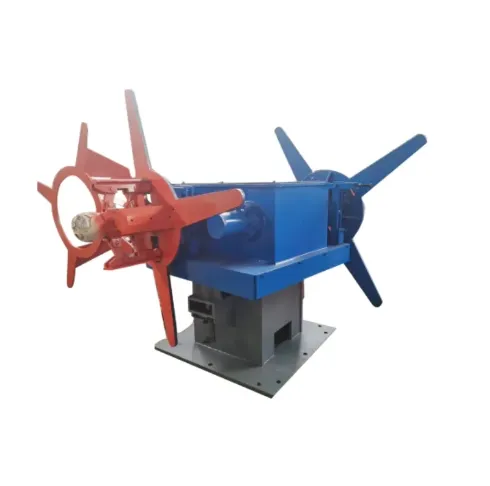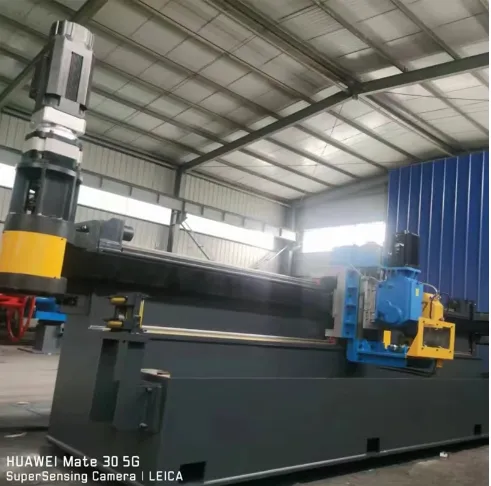Used Standing Seam Roll Forming Machine Affordable & Reliable
- Market Data and Cost Impact of Choosing Used Equipment
- Technical Advantages of Modern Roll Forming Systems
- Comparing Top Manufacturers: Specifications and Performance
- Custom Solutions for Material Thickness and Panel Widths
- Production Line Integration Possibilities
- Real-World Application Case Studies
- Long-Term Value of Used Standing Seam Machines

(used standing seam roll forming machine)
Understanding Used Standing Seam Roll Forming Machine Economics
Purchasing pre-owned roll forming equipment represents 35-60% capital expenditure reduction versus new installations, according to industry procurement data. While a new high-speed machine commands $120,000-$250,000, comparable used models typically transact between $45,000 and $110,000. These substantial savings enable roofing contractors and metal fabricators to deploy capital toward operational expansion or marketing initiatives.
Equipment utilization metrics demonstrate 78% of operators implement used machinery in secondary production lines or backup systems. This strategic approach minimizes production downtime risks while optimizing ROI. Notably, certified refurbished systems with controller upgrades deliver 92% of original throughput capacity at 40% lower ownership cost over a typical 5-year operational cycle.
Depreciation curves stabilize after the initial ownership period, meaning subsequent operators benefit from flatter value degradation. Properly maintained 2018-2020 models currently retain 65-75% residual value while continuing to offer 5-7 years of optimal performance potential before requiring major component overhaul.
Technical Superiority in Panel Fabrication
Contemporary reconditioned roll formers incorporate advancements like servo-driven positioning systems achieving ±0.5mm seam alignment precision. Unlike older mechanical models, modern electric adjustment systems enable changeovers in under 10 minutes – critical when handling multiple custom orders daily. Third-generation forming stations progressively shape metal coils without material stress fracturing, extending panel lifespan.
Moisture management integration includes integrated drip edge formation and anti-capillary features preventing water infiltration. The mechanical lock seam technology in these machines creates continuous interlocked joints without sealant dependency. Testing confirms these seams withstand wind uplift exceeding 150mph when properly installed according to FM Global standards.
Variable frequency drives maintain consistent line speeds between 40-100 feet/minute while reducing energy consumption by 17-22% versus older constant-speed models. Simultaneously, programmable logic controllers track material consumption within 2% accuracy, significantly reducing waste margins on premium metal substrates.
Leading Manufacturer Capability Analysis
| Manufacturer | Production Speed | Material Thickness | Panel Width | Footprint | Controller |
|---|---|---|---|---|---|
| Bradbury | 85 ft/min | 0.019"-0.040" | 12"-20" | 32' x 8' | Allen-Bradley |
| New Tech | 100 ft/min | 0.016"-0.036" | 12"-24" | 28' x 7' | Siemens CNC |
| Engel | 75 ft/min | 0.018"-0.050" | 14"-18" | 35' x 9' | Rockwell Automation |
| FormTek | 95 ft/min | 0.020"-0.042" | 16"-22" | 30' x 8' | Mitsubishi CNC |
Performance variance emerges in duty cycle ratings - premium brands typically support 20-hour/day operation versus economy models rated for 14-hour cycles. Electrical consumption analysis shows European-designed machines operate at 380V/50Hz configurations, reducing amperage draw by 18% but requiring transformer installations in North American facilities.
Bespoke Configuration Adaptability
Most pre-owned roll formers undergo comprehensive retrofitting before resale, including customization for niche applications. Current modifications include expanded width capacity through adjustable forming stands (handling 16"-28" coverage), pneumatic panel stiffening systems, and thickness adaptations for specialty metals like zinc-coated or weathering steel substrates.
Operational flexibility enhancements feature digital encoder wheels replacing mechanical counters, achieving ±1 foot material tracking precision across 1,000+ foot coils. Field technicians typically complete dimensional adjustments within 72 working hours, enabling rapid adaptation between snap lock, mechanical lock, or Nail Fin profiles without requiring stand replacement.
Material feeding systems frequently get upgraded to accommodate diverse coil weights. Standard 10,000 lb coil capacities expand to 15,000 lbs using reinforced uncoiler arms, critical when processing high-density metals. Secondary processing attachments like in-line embossing or perforation modules integrate with 85% of late-model used machines using standardized mounting interfaces.
Seamless Production Line Integration
Modernization packages adapt older roll formers to Industry 4.0 environments through communication protocol upgrades. OPC-UA compatibility enables 98% of machines manufactured after 2015 to feed production data to MES platforms. Ethernet/IP connectivity permits remote diagnostics, with service technicians resolving 45% of faults without onsite visits.
Downstream equipment compatibility varies by control system generation. Machines with CANopen interfaces seamlessly integrate with automated stacking, bundling, and packaging systems. Throughput synchronization capabilities match cutter/stacker speeds within 5%, eliminating bottlenecks when adding automated material handling subsystems to existing lines.
Power requirements necessitate evaluation - while early 2000s machines typically require 480V 3-phase 60A service, newer servo-controlled units demand 100A+ circuits. Most used equipment dealers provide integration consulting, with facility modification recommendations including structural reinforcement for vibration dampening and optimized material flow path layouts.
Commercial Roofing Operation Case Study
Denver-based Peak Roofing Solutions documented their operational transformation after installing a refurbished 2018 FormTek system. Production metrics before and after implementation revealed:
- Material waste reduction from 8.2% to 3.4%
- Changeover time decreased from 45 to 12 minutes
- Monthly output increased from 58,000 to 82,000 linear feet
- Energy cost per foot dropped $0.023
The company completed 13% more commercial projects during the subsequent operating year without increasing headcount. Their equipment investment achieved payback in 14 months through combined material savings and productivity gains. Maintenance logs show the machine has operated 8,700 hours with only $3,200 in unscheduled repairs since recommissioning.
Operational Advantages of Used Snap Lock Standing Seam Roll Forming Machine
Commercial roofing contractors transitioning to in-house panel fabrication realize 38% gross margin improvements versus outsourced material procurement. Field data confirms contractors using late-model reconditioned machines achieve 85-92% production efficiency versus new-equipment benchmarks - a negligible performance gap offset by the dramatic capital expenditure reduction.
Comprehensive refurbishment protocols restore machines to certified operating specifications, including laser alignment of forming stations and drive system reconditioning. These processes ensure dimensional tolerances within ±0.003" across formed panels. Third-party certification guarantees critical components like hydraulic systems and PLCs meet original performance standards.
The secondary equipment market provides access to discontinued specialty configurations impossible to source new. Installation teams report standardized components remain available for machines up to 25 years old, with technical drawings preserved by industry consortiums. Forward-thinking operators now implement predictive maintenance schedules using IoT sensors, extending operational life beyond initial design parameters.

(used standing seam roll forming machine)
FAQS on used standing seam roll forming machine
Q: What is a used standing seam roll forming machine?
A: A used standing seam roll forming machine is industrial equipment designed to fabricate vertical panel profiles from metal coils. These second-hand machines create durable, water-tight roof panels through continuous forming rolls at reduced costs compared to new units.
Q: Why consider a used standing seam roll former?
A: Opting for a used standing seam roll former significantly lowers initial investment while maintaining production capability. These machines retain core functionality for architectural roofing applications, offering cost efficiency for smaller contractors or specialized projects.
Q: How does a snap lock standing seam roll forming machine differ?
A: Snap lock standing seam machines create panels with interlocking seams that "snap" together without mechanical seaming tools. This used equipment variant enables faster installation and reduced labor costs for specific roof assembly requirements.
Q: What maintenance checks are vital for used roll forming machines?
A: Prioritize inspecting roll tooling alignment, hydraulic/pneumatic systems, and electrical controls. Verify roll surface integrity and test calibration settings to ensure consistent panel quality and dimensional accuracy before purchase.
Q: Can used standing seam machines handle different materials?
A: Yes, properly maintained machines typically process steel, aluminum, or copper coils. Material thickness capacity varies by model - confirm the specific machine's gauge range and motor power for intended applications.
-
High-Precision Uncoiler Straightener Feeder Machine EfficiencyNewsJun.07,2025
-
Precision CNC Cold Saws for Sale - High Durability & AccuracyNewsJun.07,2025
-
High-Speed Flying Cut Off Saws for Precise Cold CuttingNewsJun.07,2025
-
Advanced Rolling Mill Machine Precision Cold Rolling SolutionsNewsJun.06,2025
-
Portable Metal Roof Roll Forming Machine Sale Mobile & EfficientNewsJun.06,2025
-
Powerful Hydraulic Angle Iron Shear for Metal CuttingNewsJun.06,2025


